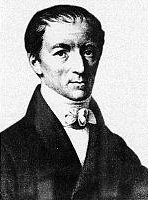Gottfried Reinhold Treviranus facts for kids
Quick facts for kids
Gottfried Reinhold Treviranus
|
|
|---|---|
 |
|
| Born | 4 February 1776 Bremen, Germany
|
| Died | 16 February 1837 (aged 61) Bremen, Germany
|
| Alma mater | University of Göttingen |
| Known for | Biology, Transmutation of species |
| Scientific career | |
| Fields | Biology, Mathematics, Medicine |
| Institutions | German Academy of Sciences Leopoldina, Royal Swedish Academy of Sciences |
| Academic advisors | Johann Friedrich Blumenbach |
Gottfried Reinhold Treviranus (born February 4, 1776, died February 16, 1837) was a German doctor and scientist. He was born and lived in Bremen, Germany. Treviranus was very interested in biology, mathematics, and medicine. He was one of the first scientists to think about how living things change over time.
His younger brother, Ludolph Christian Treviranus, was also a famous scientist. Ludolph studied plants and animals, and was good at naming and classifying them.
Contents
Who Was Gottfried Treviranus?
Gottfried Reinhold Treviranus was a very important German scientist. He was a physician, which means he was a doctor. He was also a naturalist, someone who studies nature, and an early thinker about evolution.
Early Life and Education
Treviranus was born in the city of Bremen. He went to the University of Göttingen to study medicine. In 1796, he earned his doctor's degree. This means he finished his medical studies.
The next year, in 1797, he became a professor. He taught medicine and mathematics at the Bremen lyceum, which was a type of school. Later, in 1816, he was chosen to be a member of the Royal Swedish Academy of Sciences. This is a very respected group of scientists.
Big Ideas About Life
Gottfried Treviranus had some big ideas about how living things work. He believed in something called the transmutation of species. This was an early idea about evolution. It meant that different kinds of living things could change over long periods of time.
He wrote about these ideas in his book, Biologie; oder die Philosophie der lebenden Natur. The first part of this book came out in 1802. Interestingly, another scientist named Jean-Baptiste de Lamarck had similar ideas around the same time.
What is Transmutation of Species?
The idea of transmutation of species suggests that living things are not fixed. Instead, they can slowly change and develop into new species. This was a very new and exciting idea at the time. It helped set the stage for later theories of evolution, like the one developed by Charles Darwin.
Seeing the World: Eye Discoveries
Treviranus also made important discoveries about how we see. In the 1830s, he was the first person to identify special cells in the retina of the eye. These cells are called rod photoreceptor cells. He used a microscope to see them. Rod cells help us see in dim light and detect movement. This was a big step in understanding how our eyes work.
Main Writings
Treviranus wrote several important books and papers. His most famous work was:
- Biologie; oder die Philosophie der lebenden Natur (1802–1822): This is where he shared his ideas about the transmutation of species.
- Beiträge zur Lehre von den Gesichtswerkzeugen und dem Sehen des Menschen und der Thiere (1828): This book was about how eyes work and how we see.
- Beiträge zur Aufklärung der Erscheinungen und Gesetze des organischen Lebens (1835–1838): He wrote this with his brother, Ludolph Christian Treviranus. It explored the rules and events of organic life.
See also
 In Spanish: Gottfried Reinhold Treviranus para niños
In Spanish: Gottfried Reinhold Treviranus para niños

